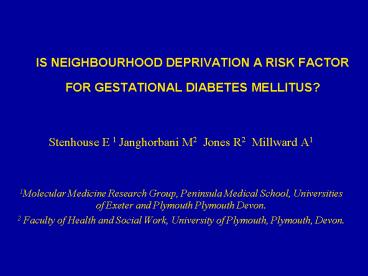IS NEIGHBOURHOOD DEPRIVATION A RISK FACTOR FOR GESTATIONAL DIABETES MELLITUS - PowerPoint PPT Presentation
1 / 14
Title:
IS NEIGHBOURHOOD DEPRIVATION A RISK FACTOR FOR GESTATIONAL DIABETES MELLITUS
Description:
IS NEIGHBOURHOOD DEPRIVATION A RISK FACTOR FOR GESTATIONAL DIABETES MELLITUS? ... Gestational diabetes mellitus (GDM) is defined as carbohydrate intolerance that ... – PowerPoint PPT presentation
Number of Views:35
Avg rating:3.0/5.0
Title: IS NEIGHBOURHOOD DEPRIVATION A RISK FACTOR FOR GESTATIONAL DIABETES MELLITUS
1
IS NEIGHBOURHOOD DEPRIVATION A RISK FACTOR FOR
GESTATIONAL DIABETES MELLITUS?
- Stenhouse E 1 Janghorbani M2 Jones R2 Millward
A1 - 1Molecular Medicine Research Group, Peninsula
Medical School, Universities of Exeter and
Plymouth Plymouth Devon. - 2 Faculty of Health and Social Work, University
of Plymouth, Plymouth, Devon.
2
Background
- Gestational diabetes mellitus (GDM) is defined as
carbohydrate intolerance that begins or first
recognized during pregnancy - GDM is associated with increased maternal and
infant morbidity and mortality - Women with GDM have a 17 - 63 risk of Type 2
Diabetes Mellitus (T2DM) within 5 -16 years - Risk factors for GDM are high maternal age,
weight and parity, previous delivery of
macrosomic infants, family history of diabetes,
and race/ethnicity
3
Background (2)
- Association between socioeconomic status (SES)
and T2DM is well established - Yet evidence on the relationship between GDM and
SES is limited - An Italian suggested that the prevalence of GDM
is increased with decreasing educational level, a
marker of SES - Another marker of SES is neighbourhood
deprivation (ND) a known risk factor for T2DM yet
little research has been undertaken to explore ND
and GDM
4
Aim
- To explore the relationship between neighbourhood
deprivation and the prevalence of GDM using
routinely collected data
5
Methods
- 3933 Caucasian pregnant screened for GDM between
01/01/1996 and 31/12/1997 in Plymouth, South-West
England - All mothers undergo routine screening via a
random plasma glucose at 26 28 weeks gestation - If this is gt 6.5mmol/l - diagnostic 75g Oral
glucose tolerance test - A selection of mothers are identified via risk
factors
6
Methods(2)
- GDM is diagnosed
- 2 hr plasma glucose level 7.8 and/or the
fasting plasma glucose 6.0 mmol/l - Data were obtained from
- Plymouth Child Health Database
- Derriford Combined Laboratory database
- Midwifery care notes
- Data included
- date of birth of mother and infant
- babys gender
- gestational age (weeks)
- birth weight
- post code
7
Methods (2)
- Level of ND was calculated by the use of Townsend
Material Deprivation Score (TMDS) and small area
boundaries - (Small area refers to neighbourhood units in
Plymouth with an average population of 5,500
residents) - TMDS ranged from - 5.0 to 8.1
- (Higher scores indicate high deprivation)
- The TMDS were divided into three equal tertiles
8
(No Transcript)
9
Analysis
- Comparisons between means
- Students t-test for independent samples
- Comparisons between proportions
- Chi-square or Fishers exact test
- Correlation between continuous variables
- Pearson coefficient
- Analysis of factors relating to GDM
- Stepwise logistic regression
10
Results
- 65 (1.7) 95 CI 1.20, 2.11 women with
- and
- 3868 (98.3) without GDM
- Women with GDM were
- older
- higher mean random plasma glucose level
- Higher infant birth weight
- Lower mean TMDS
11
Results (2)
12
Results (3)
- However when further analysis was performed to
determine the independent predictors of factors
associated with GDM (mothers age, TMDS and
birth weight - Mothers from the most deprived neighbourhoods
were less likely to develop GDM than those from
the most affluent areas - TMDS, birth weight and gender had no significant
independent association with GDM - Relative Prevalence 0.50 (95 CI 0.27, 0.94) p
0.06 - The mean age at delivery decreased with
increasing TMDS in both mothers with r -0.325
p lt 0.01 and without GDM r -0.246 p lt 0.001
13
Discussion
- Studies would suggest that women from more
deprived areas might be at higher risk of GDM
compared to those in more affluent areas - Our study found no such relationship
- Adjusting for other risk factors
- older women were more likely to develop GDM
- Yet deprivation and birth weight had no impact on
the risk of GDM
14
Conclusions
- The findings of this study support the notion
that the neighbourhood context in which women
live has no impact on the risk of GDM. - To our knowledge, this is the first
representative study to assess association
between neighbourhood context and GDM - It highlights the need for further studies that
identify sub-populations at high risk for GDM - In particular work in areas where there is no
marked association between deprivation and age
would be worthwhile































